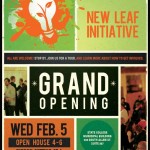The New Leaf Initiative – A New Coworking Space in Downtown State College
by Dr. Tim Simpson
 If you are student, undergraduate or graduate, or faculty member wanting to do entrepreneurial “things” and haven’t heard of New Leaf Initiative yet, you are missing out on some great networking opportunities and are probably not aware of the new coworking space that is opening this February in State College.
If you are student, undergraduate or graduate, or faculty member wanting to do entrepreneurial “things” and haven’t heard of New Leaf Initiative yet, you are missing out on some great networking opportunities and are probably not aware of the new coworking space that is opening this February in State College.
New Leaf started more than 3 years ago by Spud Marshall, Christian Baum, and Eric Sauder, and has become an integral member of our local entrepreneurial ecosystem. When New Leaf first opened, it operated out of 100 South Fraser Street—across the street from Hammond Building, beneath Dunkin Donuts, the same place Freeze Thaw Cycles began. Marshall and Baum have since spun-out co.space, leaving Sauder and Serena Fulton, the newest edition to the team, to run New Leaf.
Now, New Leaf is on the verge of opening a 2,500 sq. foot coworking space in the 3rd floor of the State College Borough Building, located at 243 South Allen Street, one building south of the Schlow Library. New Leaf offers a variety of coworking memberships, which provide either 10, 20, or 40 hours per week of access to desks and private meeting space. The rates are reasonable and all inclusive, and more than 20 companies and local entrepreneurs have signed up thus far (full house is about 36 members, and they are gunning for >80% occupancy when they open next month).
So how do I know so much about New Leaf and their new endeavor? Well, New Leaf has been my “secret office” in town while I’ve been on sabbatical (did you see me in their photos yet?). Working at New Leaf has provided unique insight into our local entrepreneurial ecosystem, from literally right across the street. It has been a great way to network with local entrepreneurs in a range of industries, as well as get to know people working in the Borough and Chamber of Business and Industry Centre County. There are some phenomenal people who are working very hard to make State College and Happy Valley a mecca for recruiting talented entrepreneurs into the area and, more importantly, providing opportunities to students and alumni to stay in the area to work on their latest invention and innovation. I’ve been renting my own desk space in New Leaf, and I’ve lost count of how many students and faculty I’ve helped connect to local ecosystem. It’s worked equally well in reverse, as I’ve been able to help connect many local entrepreneurs with people and resources at Penn State. In fact, being on the outside this year has been very eye opening in many regards, including how difficult it is for local entrepreneurs to navigate the wealth of resources at Penn State and connect with the right people (maybe it’s time for a 1-800-PSU-ESHIP number?).
There are other incubators and office spaces in town, and Penn State is involved with two facilities: (1) Technology Center at Innovation Park and (2) Zetachron in Science Park. Rates vary depending on what you need (e.g., $14-16/sq. ft. for office space; $20/sq. ft. and up for wet lab space), and there are some cool start-ups incubating there now. More important, however, is the list of successful former tenants of which I was previously unaware. It’s an impressive list when you read it.
I think New Leaf’s coworking space will complement these existing incubator spaces well and provide a shared working space within walking distance of campus, which may be attractive to students and faculty just starting out on their entrepreneurial journey. I’ve put down my own money (not PSU’s money or my grant money) for a 10hr/week membership, and I’m looking forward to helping shape the culture in this new space while continuing my entrepreneurial cross-training.
If this interests you and you want to learn more the New Leaf Initiative and their coworking space, check out the Grand Opening is Wed, Feb. 5 from 4-6pm in 243 South Allen Street.
Tim Simpson is a professor in both mechanical engineering and industrial engineering. He holds affiliate appointments in the School of Engineering Design, Technology, and Professional Programs (SEDTAPP) and the College of Information Sciences & Technology. From 2007-2012, he served as director of the Learning Factory, and now he serves as co-Director of the Center for Innovative Materials Processing through Direct Digital Deposition (CIMP-3D), a DARPA-funded Manufacturing Demonstration Facility for Additive Manufacturing. This is his second sabbatical.
Read More





Follow Us!